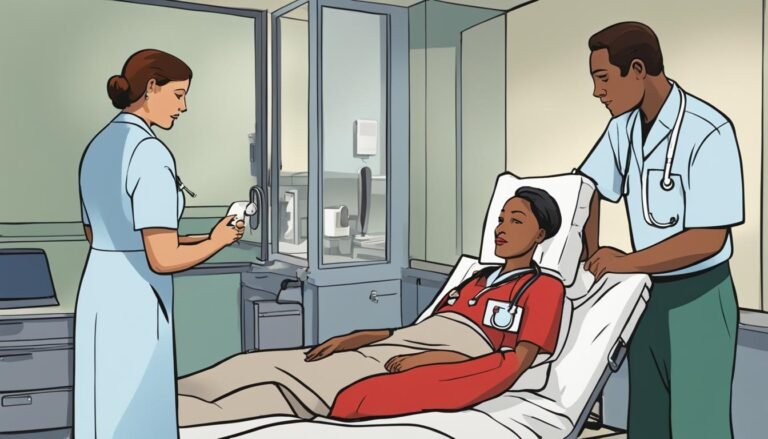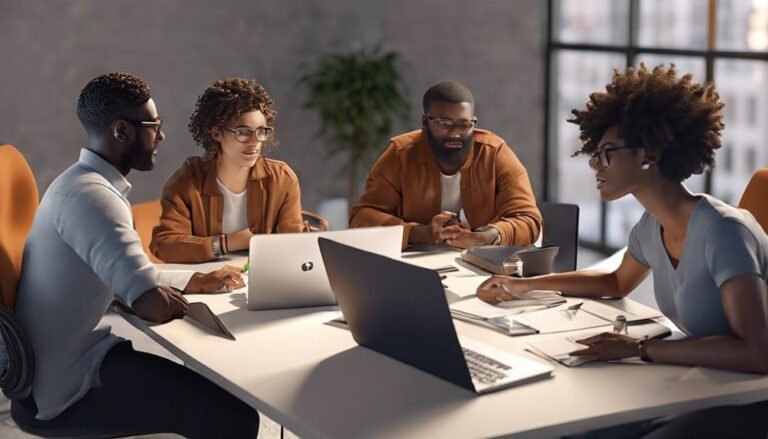Soft Skills for Trainer
Master essential soft skills to boost your training impact. Enhance communication, teamwork, and productivity by developing emotional intelligence. Engage participants with interactive methods and active listening. Build connections through empathy, genuine interest, and acknowledging emotions. Improve communication with body language awareness and eye contact. Stay adaptable by adjusting based on feedback and creating dynamic learning atmospheres. Strategies like role-playing, team-building activities, and peer feedback sessions are key. These techniques elevate your training game.
Key Takeaways
- Active listening techniques enhance communication skills.
- Body language awareness is crucial for effective training.
- Maintaining eye contact shows attentiveness and engagement.
- Nonverbal cues convey important messages to participants.
- Mirroring body language helps build connections with trainees.
Importance of Soft Skills in Training
Soft skills are essential in training as they enhance communication, foster teamwork, and improve overall productivity. When it comes to emotional intelligence development, trainers must be adept at recognizing and managing their emotions effectively. Interactive training methods can help in honing these skills by encouraging active participation and engagement from trainees.
Relationship building is another critical aspect where soft skills play a significant role. Trainers need to establish rapport with their audience to create a conducive learning environment. Effective communication techniques, such as active listening and empathetic responses, are essential for building trust and understanding among participants.
Active Listening Techniques for Trainers
When training, remember the power of engaging listening activities to keep participants involved and focused.
Utilize reflective questioning techniques to encourage deeper thinking and enhance learning outcomes.
Employ empathetic response strategies to create a supportive and understanding training environment.
Engaging Listening Activities
To truly connect with your audience as a trainer, incorporating engaging listening activities into your sessions is crucial for fostering a dynamic and interactive learning environment. Interactive role-playing is a potent tool that allows participants to step into different scenarios, encouraging active listening and enhancing communication skills.
By engaging in imaginative storytelling, trainers can captivate their audience, making the learning experience more enjoyable and memorable. These activities not only promote listening but also help in building empathy and understanding among participants.
Through interactive role-playing and creative storytelling, trainers can create a safe space for individuals to practice active listening techniques while developing their interpersonal skills. Keep these activities diverse and engaging to ensure maximum participation and learning retention.
Reflective Questioning Techniques
Explore how reflective questioning techniques can elevate your training sessions by deepening participant engagement and enhancing active listening skills. By incorporating reflective questions, you can improve engagement and foster curiosity among your trainees.
Encourage them to think critically about the material being discussed by posing questions that require thoughtful responses. This approach not only keeps participants actively involved but also helps them retain information better.
When you utilize reflective questioning techniques, you create a space for meaningful dialogue and deeper understanding. Remember to listen attentively to their responses, acknowledging their contributions, and building upon their answers.
Empathetic Response Strategies
Enhance your training sessions by incorporating empathetic response strategies, utilizing active listening techniques to deepen connections with your participants. When practicing empathy building, it's essential to actively listen and respond thoughtfully. Here are some techniques to foster connections effectively:
| Empathetic Response Strategies | Description | Benefits |
|---|---|---|
| Reflective Listening | Paraphrase what participants say, | Enhances understanding |
| showing you understand their | and rapport-building | |
| perspective. | ||
| Open-Ended Questions | Encourage participants to share | Promotes deeper insights |
| more by avoiding simple yes or no | and encourages engagement | |
| answers. | ||
| Non-Verbal Cues | Pay attention to body language | Helps in understanding |
| and tone of voice to fully grasp | emotions and sentiments | |
| participants' feelings. |
Building Empathy and Connection
Strengthen your ability to understand and connect with others by honing your empathy skills as a trainer. Developing rapport and fostering understanding are essential components of building empathy and connection in your training sessions. To establish a strong connection with your trainees, actively listen to their concerns, show genuine interest in their perspectives, and acknowledge their emotions. By demonstrating empathy, you create a supportive environment where individuals feel valued and understood.
Empathy goes beyond just understanding; it involves putting yourself in someone else's shoes to comprehend their experiences fully. As a trainer, this skill is invaluable in building trust and enhancing relationships with your trainees. When you empathize with others, you create a safe space for open communication and collaboration. This, in turn, leads to a more positive and productive learning environment.
Enhancing Communication Skills
Ready to take your communication skills to the next level?
By focusing on active listening techniques and body language awareness, you can greatly enhance your ability to connect with others.
These key points will help you become a more effective and empathetic communicator in your role as a trainer.
Active Listening Techniques
Improving your communication skills can be greatly aided by mastering active listening techniques. By improving focus and developing rapport through active listening, you can enhance your interactions with others.
One key technique is maintaining eye contact to show your attentiveness and interest in the conversation. Additionally, nodding and using verbal cues like 'I see' or 'Go on' demonstrate that you're actively engaged in what the speaker is saying.
It's important to avoid interrupting and instead wait for natural pauses to ask clarifying questions or provide feedback. Remember, active listening isn't just about hearing words but also understanding the emotions and intentions behind them.
Practice these techniques to become a more effective communicator.
Body Language Awareness
Enhance your communication skills by paying attention to body language cues, a key aspect of effective interaction. Nonverbal cues play an essential role in conveying messages and understanding others. Observing gestures, facial expressions, and posture can provide valuable insights into a person's feelings and thoughts, complementing the spoken words.
By being aware of nonverbal signals, you can enhance your communication effectiveness substantially. For instance, maintaining eye contact shows attentiveness and interest, while crossed arms may indicate defensiveness or disagreement. Mirroring the body language of others can help establish rapport and build connections.
Adaptability in Training Situations
In training situations, the ability to quickly adjust your approach based on the participants' feedback and needs is an essential skill known as adaptability. Being flexible and approachable allows you to create a dynamic learning environment where participants feel valued and engaged. Versatility is pivotal as every training session will have its unique challenges and requirements. By being responsive to the cues and reactions of your audience, you can tailor your delivery to guarantee maximum comprehension and retention.
Adaptability means being able to switch gears if a particular training method isn't working effectively. It involves thinking on your feet, adjusting your pace, tone, or even content to better suit the group's learning style. Demonstrating adaptability shows that you're attentive to the participants' needs and are willing to go the extra mile to make sure their learning experience is fruitful. Remember, adaptability isn't a sign of weakness but a strength that showcases your ability to think critically and adjust to ever-changing circumstances in the training room.
Strategies for Developing Soft Skills
To further hone your training skills, consider implementing structured exercises and interactive techniques that promote the development of soft skills. These strategies focus on enhancing communication development, emotional intelligence training, interpersonal skills, and relationship building exercises. By incorporating these methods into your training sessions, you can create a more engaging and effective learning environment for your participants.
| Soft Skills Development Strategies | Description | Benefits |
|---|---|---|
| Role-playing scenarios | Engage participants in simulated real-life situations to practice effective communication and empathy. | Enhances communication skills and emotional intelligence. |
| Team-building activities | Encourage collaboration and foster trust among team members through group challenges and problem-solving tasks. | Improves interpersonal skills and builds strong relationships. |
| Peer feedback sessions | Provide a platform for participants to give and receive constructive feedback to improve their interactions and understand different perspectives. | Facilitates self-awareness and promotes continuous self-improvement. |
Conclusion
Now that you've learned about the importance of soft skills for trainers, remember that mastering these skills is like having a superpower in the training world.
By honing your active listening, empathy, communication, and adaptability, you can truly connect with your trainees and make a lasting impact.
So go forth and demonstrate your soft skills prowess – you'll be unstoppable in the training arena!








